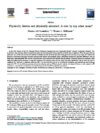Abstract
In the 2013 release of the U.S. National Physical Education Standards the term “physically literate” replaced “physically educated”. Unfortunately, most discourse within the profession about the term physically literate occurred primarily after its adoption. While we agree with the spirit and intent of the term, we feel it is essential to discuss not only what has been potentially gained but also lost. In our paper, we illustrate the similarity of the terms physically educated and physically literate and essentially, from a definitional perspective, find little difference—but are these terms interchangeable? We provide a critical review of the standards and conclude that the change to physical literacy has produced a shift away from psychomotor outcomes to cognitive outcomes. Our concerns about this are many, but most importantly they are about the need to emphasize the “physical” in physical education (PE). It is our belief that the key to elevating the profession and maintaining and increasing support for PE is in its ability to promote and provide physical activity. Without physical activity and physical fitness as main outcomes, PE increases its vulnerability to extinction as a standard part of the U.S. K-12 education curriculum.



Responses